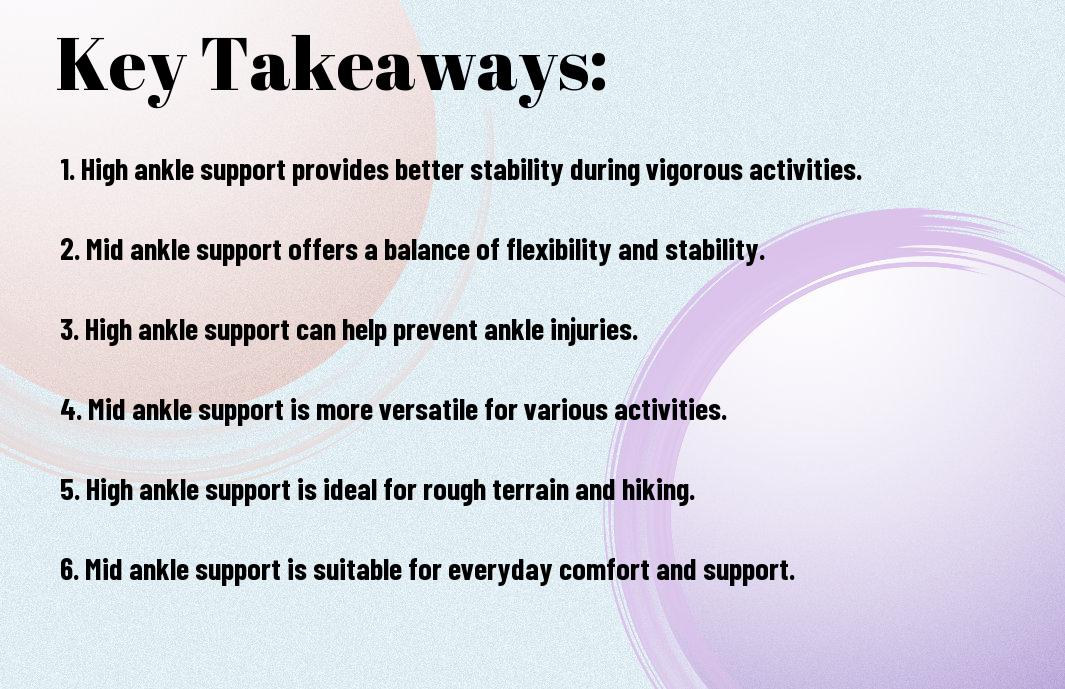It’s time to lace up your shoes, but before you hit the trails, you need to consider the importance of ankle support. Choosing between high and mid ankle support can make a significant difference in your comfort and stability during physical activities. Let’s explore into the nuances of high versus mid ankle support to help you make an informed decision that suits your needs and protects your ankles effectively.

Ankle Anatomy and Importance of Support
The Structure of the Ankle Joint
One important aspect that you must understand when considering ankle support is the intricate structure of the ankle joint. Your ankle joint is composed of three main bones: the tibia, fibula, and talus. These bones come together to form a hinge joint that allows for up and down movement of the foot. Ligaments, tendons, and muscles provide stability and support to the joint, allowing for a range of motion while also preventing excessive movements that can lead to injuries.
How Ankle Support Affects Performance and Injury Prevention
Anatomy plays a crucial role in how ankle support can impact your performance and reduce the risk of injuries. By providing external support to the ligaments and tendons around the ankle joint, supportive footwear can enhance proprioception and stability. This can lead to improved balance, agility, and overall performance in various physical activities.
High Ankle Support
Definition and Characteristics
One of the key features of high ankle support is the design that extends above the ankle joint, providing additional stability to the ankle and surrounding areas. This type of support typically includes padding and straps that secure the ankle firmly in place. High ankle support is commonly found in boots or shoes designed for hiking, mountaineering, and other high-impact activities.
Benefits of High Ankle Support
Any time you engage in activities that involve uneven terrain, sudden movements, or heavy loads on your feet, high ankle support can be crucial in preventing injuries. The added stability and protection offered by high ankle support can help reduce the risk of sprains, twists, or other trauma to the ankle joint. Additionally, the compression provided by high ankle support can improve blood circulation and reduce swelling during and after physical activity.
Supportive footwear with high ankle support can enhance your performance and confidence in challenging environments. The reinforced structure around the ankle helps maintain proper alignment, reducing the strain on your muscles and joints as you move. By choosing high ankle support, you are investing in the long-term health and functionality of your ankles, especially during strenuous activities.
Situations Where High Ankle Support is Essential
Support in high-intensity activities like running, hiking, or playing sports, where sudden movements and changes in direction are common, high ankle support becomes necessary. The risk of rolling or twisting your ankle is higher in such scenarios, making the extra stability provided by high ankle support invaluable. Whether you are navigating rocky trails, sprinting on the field, or carrying heavy loads, high ankle support can significantly reduce the chances of ankle-related injuries.
Mid Ankle Support
Despite the popularity of high ankle support in athletic footwear, mid ankle support has its own set of unique benefits and characteristics that make it a popular choice for many athletes and outdoor enthusiasts.
Definition and Characteristics
Supporting the ankle just above the level of the ankle bones, mid ankle support provides a balance between flexibility and stability. This type of design allows for a greater range of motion compared to high ankle support while still offering adequate support and protection to the ankle joint.
Benefits of Mid Ankle Support
With mid ankle support, you can enjoy a more natural feel and movement during your activities while still getting the stability and protection you need. The slightly higher design helps prevent excessive rolling of the ankle without restricting your mobility, making it a versatile choice for various sports and outdoor adventures.
Benefits of mid ankle support include improved proprioception, which is your body’s ability to sense its position, motion, and balance. This can enhance your overall performance and reduce the risk of ankle injuries during dynamic movements like cutting, jumping, and pivoting.
Situations Where Mid Ankle Support is Preferred
Characteristics of mid ankle support make it a preferred choice for activities that require a good balance between support and flexibility. If you participate in sports that involve frequent changes in direction, agility movements, or uneven terrains, mid ankle support can provide the right amount of stability without hindering your performance.
Plus, mid ankle support is also a popular choice for individuals who have previously experienced ankle injuries or instability but still want to maintain a certain level of freedom of movement. The moderate support offered by mid ankle shoes can help prevent re-injury while allowing you to stay active and agile.
Key Differences Between High and Mid Ankle Support
All ankle support options aim to protect your ankle by offering stability and restriction. However, the level of stability and restriction differs between high and mid ankle support options.
Level of Stability and Restriction
One key difference between high and mid ankle support is the level of stability they provide. High ankle support typically offers more stability and restriction compared to mid ankle support. This is because high ankle support extends up the calf, providing additional support to the ankle joint and surrounding muscles. If you have a history of ankle injuries or participate in high-impact activities, you may benefit from the increased stability that high ankle support offers.
Weight and Bulkiness
An important consideration when choosing between high and mid ankle support is the weight and bulkiness of the support. High ankle support tends to be bulkier and heavier due to its extended design. This extra material can provide additional protection but may also feel cumbersome, especially during activities that require agility and speed.
Ankle support that is too heavy or bulky can hinder your performance in sports that require quick movements and agility. It’s crucial to find a balance between support and freedom of movement to ensure you can perform at your best while still protecting your ankle from potential injuries.
Activity-Specific Requirements
Understanding the specific requirements of your activities is crucial when choosing between high and mid ankle support. Certain activities, such as basketball or hiking on rugged terrain, may benefit from the extra stability offered by high ankle support. On the other hand, activities that require more flexibility and agility, like soccer or running, might be better suited for mid ankle support, which offers a balance of support and mobility.
Activity-specific needs should guide your decision when selecting ankle support to ensure you can perform comfortably and safely in your chosen physical endeavors. Consider the demands of your favorite activities and choose the ankle support that best aligns with those needs.
Choosing the Right Ankle Support for Your Needs
Assessing Your Ankle Type and Instability
Keep in mind that understanding your ankle type and level of instability is crucial when deciding on the right ankle support. Ankle injuries can vary from mild to severe, and the level of stability your ankles need will depend on factors like previous injuries, your natural range of motion, and any conditions that may affect your ankle health.
Considering Your Activity Level and Type
Ankle support should also be chosen based on the activities you regularly engage in. If you have a high activity level or participate in sports that involve quick movements and directional changes, you may require more robust ankle support. Conversely, if you lead a more sedentary lifestyle, or simply need ankle support for daily activities, a mid-level support may suffice.
Support
When deciding on the level of ankle support you need, it’s imperative to consider the impact of your activities. High ankle support is typically recommended for high-impact sports like basketball, soccer, or running, where the risk of sprains and injuries is greater. On the other hand, mid-level ankle support can provide stability and comfort for activities like walking, light exercise, or daily tasks.
Factors to Consider for Customized Ankle Support
The type of ankle support you choose should also take into account factors like the fit, material, and adjustability. Customized ankle support options, such as adjustable straps, lace-up designs, or orthotic inserts, can provide a personalized fit that addresses your specific needs.
- Proper fit and sizing of the ankle support
- Material and breathability for comfort
- Adjustability and adaptability for different activities
Recognizing these factors can help you tailor your ankle support to provide the best possible protection and stability for your ankles.
Real-World Applications and Examples
High Ankle Support in High-Impact Sports
Not all ankle support is created equal, especially when it comes to high-impact sports. For activities like basketball, soccer, or running, where the possibility of sudden twists and turns is high, opting for high ankle support can provide added stability and protection. High ankle support braces or shoes with extended collars can help reduce the risk of ankle sprains and injuries by limiting excessive movement and providing extra reinforcement to the joint.
Mid Ankle Support in Low-Impact Activities
RealWorld when engaging in low-impact activities such as walking, light jogging, or yoga, mid ankle support may be more suitable. While still offering some level of protection and stability, mid ankle support allows for a greater range of motion compared to high ankle support. This flexibility can be beneficial in activities that do not involve quick direction changes or intense impact on the joints, providing a balance between support and mobility.
LowImpact It’s crucial to match the level of ankle support to the specific demands of the activity you are engaging in. You want to ensure that your ankles have the necessary support to prevent injuries while also allowing for optimal movement and comfort. By understanding the type of support needed for different activities, you can make informed choices to protect your ankles effectively.
Everyday Use and Prevention
For everyday activities like walking, standing for long periods, or doing light chores around the house, incorporating ankle support can help prevent fatigue and strain on your joints. While high ankle support may not be necessary for these low-impact tasks, opting for shoes with adequate cushioning and moderate ankle support can provide added comfort and stability. It’s crucial to prioritize the health of your ankles in your daily routine to prevent long-term issues and ensure overall well-being.
Ankle By paying attention to the level of ankle support you need based on the activity at hand, you can protect yourself from unnecessary injuries and discomfort. Whether you opt for high ankle support in high-impact sports, mid ankle support in low-impact activities, or incorporate ankle support into your daily life, taking proactive measures can go a long way in maintaining healthy and strong ankles.
Conclusion
Upon reflecting on the comparison between high and mid ankle support, it is evident that both options offer distinct benefits depending on your needs and preferences. High ankle support provides superior stability and protection for intense activities like hiking or basketball, while mid ankle support offers a balance of support and flexibility suitable for everyday use or lighter activities.
Ultimately, the choice between high and mid ankle support comes down to your specific requirements and the level of support you need for your daily activities. Consider factors such as the intensity of your physical activities, the duration of wear, and your comfort preferences to make an informed decision that will enhance your overall performance and protect your ankles from injury.
